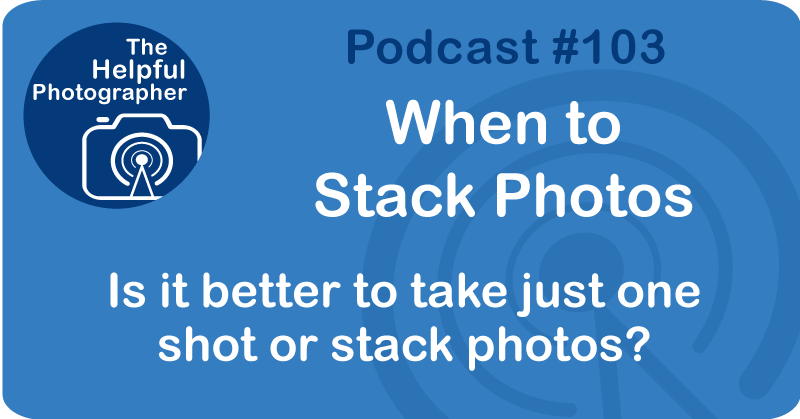When to Stack Photos #103
When to Use a Polarizing Filter #102

Is it better to get it in one shot or to stack photos? Let's talk about when photographers are stacking photos. Astrophotography. Serious astrophotographers probably use photo stacking more frequently than any other group of photographers I know. There are a few reasons for this. In order to get the image that they want, it often takes hours to acquire that information. But leaving your sensor on for that amount of time would introduce a ton of noise. To get around this problem, astrophotographers take dozens to thousands of short exposures and then stack them together to get the photo they want, whether it's light trails or photographing a nebula. If you want to know why long exposure is a problem for astrophotographers, that was explained in episode 51. The only time they probably don't stack photos is when they're photographing the moon because there's actually plenty of light.
Another common reason why photographers stack photos is when they have a high dynamic range problem. In other words, when you have a high contrast situation and one photo won't give you all the detail you want in both the light and the dark areas. In that instance, you would bracket your photo and then stack them in post-process. Bracketing means that you're shooting multiple photos of the same scene at varying exposures to make sure that you have good detail in the darkest and brightest areas of the scene. By creating these exposures, you can combine them in the post-process for a perfectly exposed image where you have good detail everywhere, from the black areas to the white areas.
Another reason why photographers are stacking images is for focus. Focus stacking is when you stack photos that are taken at varying focus distances, and then stack them together for an image that is sharp everywhere. Unless you're shooting a very small sensor, like with your smartphone, and also a subject that is very far away, you are probably going to have some areas that are blurry due to depth of field issues. And so the only way to get everything sharp is to focus stack.
The last reason I can think of to stack photos, and probably the least common would be to get rid of people or things that are moving through the image. If you take multiple photos of a specific scene, like a New York City sidewalk, and you don't want people in your photo, you have two options. You can do a long exposure, long enough for the people to simply disappear, or you can do multiple exposures. If you do multiple exposures and the people are in different parts of the frame for each photo, then programs like Lightroom will simply scrub them from the photo, leaving the scene void of people.
So the question that was asked on a recent Instagram live session was, is it better to take one photo or to stack photos? My answer is, it really depends on what you're shooting and what you want the photo to look like. I think outside the parameters I just laid out, I can't imagine a scenario where you would need to stack. If I do learn of something, I'll be sure to put it in another podcast. I hope that was helpful. Until next time, keep on shooting.











